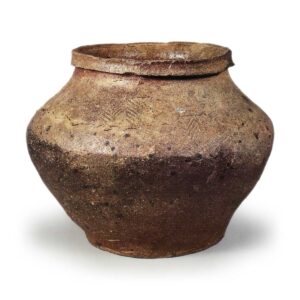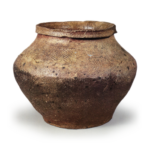
14th century
Height 17.0 cm, mouth diameter 13.5 cm, body diameter 22.0 cm, bottom diameter 13.0 cm
From the end of the Kamakura period (1185-1333) to the first half of the Muromachi period (1333-1573), many small jars like this one were made. They were probably made as everyday containers for practical use, but there are a surprisingly large number of examples used as warehouses for storage, along with Kosedo vases. Each of these vessels has a flattened, arithmetic-board-shaped body with a large base that extends directly from the shoulder to the rim of the mouth. This jar has two twill-sugi shaped imprints on the shoulder, but many of them have two or three imprints of this type. This type of small jar was called “fushiki” in Tokoname, and many of them were made as water jars in later periods. The name “fushiki” is said to have come from an inscription on an old Tokoname jar given to Sen no Rikyu by Mizuno Katsumono, lord of Tokoname Castle in the late Muromachi period.








